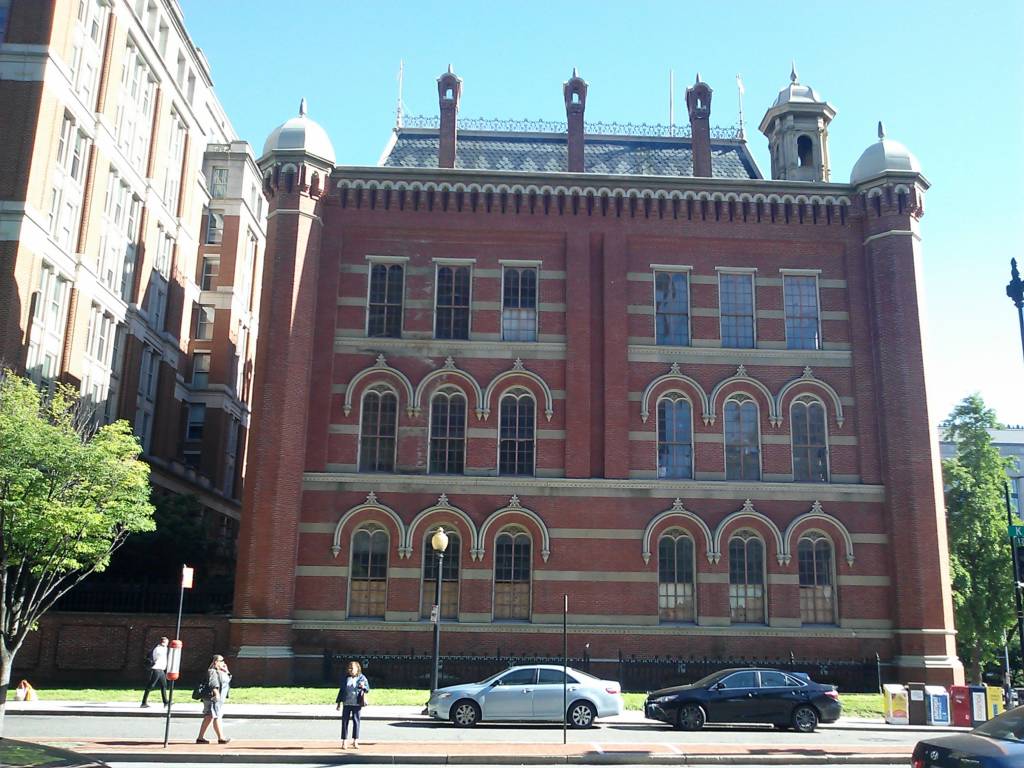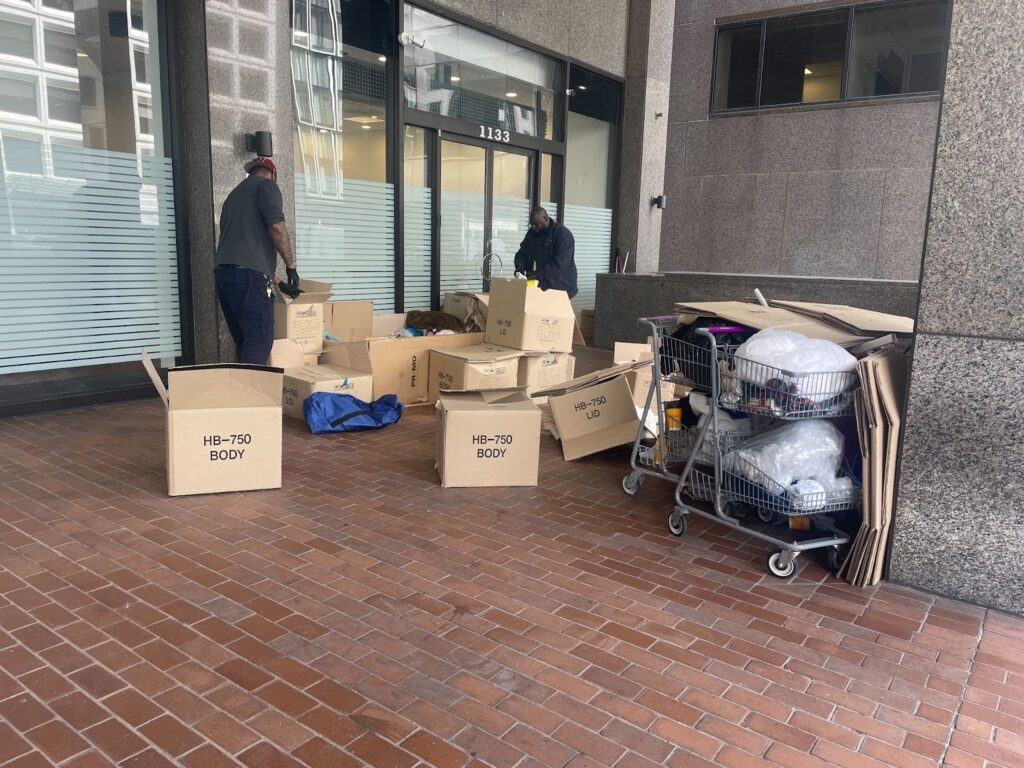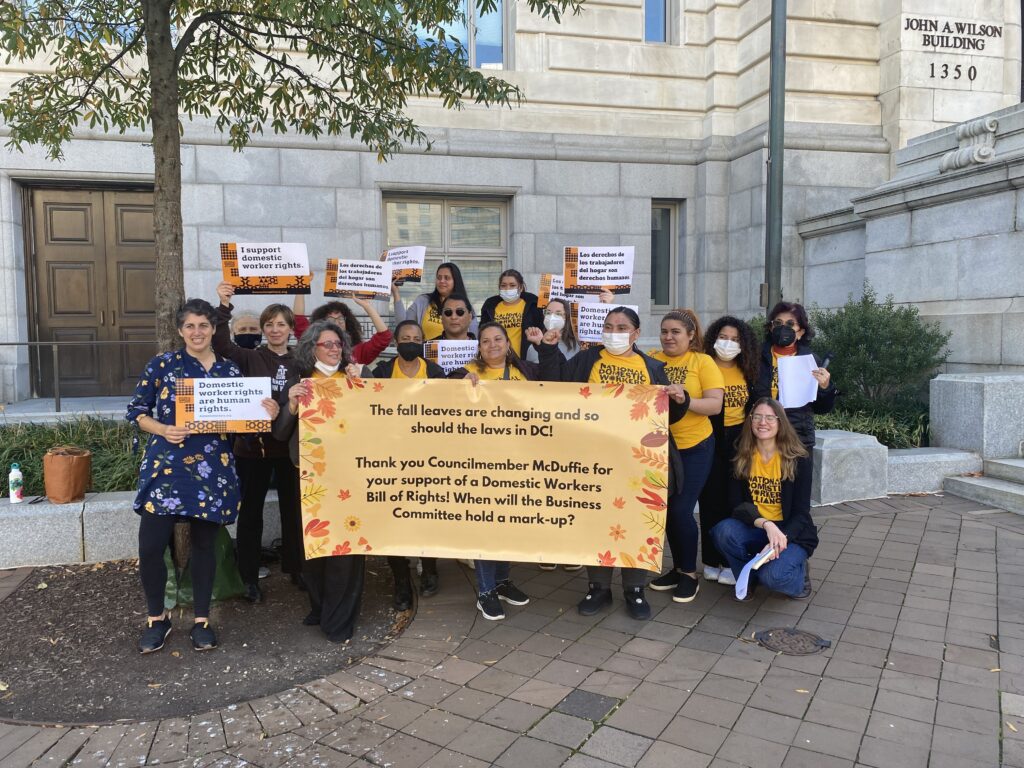It has now been two months since the Martin Luther King Jr. Memorial Library branch closed its doors for an estimated three-year renovation. This renovation has been in the works since at least early 2014 when the public chose one of three innovative design teams to remodel the facility. The closing of the library created a gap in services for the homeless community that the city aims to solve by opening a downtown day center. But downtown services have been needed since long before that.
In 2004, Gales School Shelter closed and its residents were moved out of downtown Northwest and into a new facility: a literal warehouse and former halfway house off New York Avenue Northeast, in Ivy City.
Then, in 2008, as then-journalist Elissa Silverman reported for the Washington Post at the time, Franklin School shelter closed. (pictured above) Willing residents were moved to St. Elizabeth’s campus in Congress Heights. Others survive downtown in other ways, including occupying Franklin Park, which is also slated to close for redevelopment soon. Some go to Adams Place Men’s Shelter in Northeast: another warehouse, turned halfway house, turned shelter.
The trend of fewer services downtown can be seen as far back as 1991 when a shelter closed at 14th and Q St NW after the city cut its budget for emergency shelter by $11 million. No new facility was opened — in fact, a shelter also closed that year at 13th and G streets NE. The city social service commissioner at the time admitted this was a problem and said the only hope for the growing homeless population was aid from the community.
The last city-funded shelter for men in Northwest, La Casa in Columbia Heights, closed in 2010. Some of the residents filed a class-action lawsuit alleging “disparate impact” since the shelter closings forced homeless people out of the heart of the city for shelter, and an overwhelming majority of homeless people are Black and brown. The suit was eventually dismissed.
Low-barrier shelters require that residents leave between 7 a.m. and 7 p.m., and a number of day programs rose up over the years to fill this time with access to services. They too struggle to remain in Northwest D.C., however. Hermano Pedro, a staple in the Columbia Heights community near the La Casa site, closed after 10 years of service when their contract was not renewed.
The city van system has shuttled shelter residents downtown for meal programs, library access and more for years. Many libraries end up serving as de facto day centers: providing computer access, shelter from the elements, quiet, relative security and entertainment to be found in books and more. The D.C. library was one of the first in the country to hire a social worker, and the MLK branch, in particular, served as a prominent pickup and drop-off location for the shelter vans.
The city opened its own day center in 2015 to fulfill goals identified in the mayor’s five-year plan to end homelessness. It even hired homeless people to help staff the center and its outreach team to assist their peers. However, the center is connected to the remote Adams Place Men’s Shelter, off the beaten path of many potential clients. At meetings surrounding the MLK branch closure, city officials have agreed that a downtown day program is necessary, but that space has been hard to come by. A Department of General Services request for space issued on May 20, 2016, is seeking 8,000 to 10,000 square feet for the facility. The June 20, 2016, deadline for space offers has come and gone. But the Deputy Mayor of Health and Human Services aims to have settled on a space by July 1 of this year, wrote Program Analyst Ben Link in an email.
Such a central location would serve to combine services such as showers, laundry and assessment for need-based housing — as well as assist the various outreach teams to locate their clients as needed. The community has been in discussions about several buildings that could be a useful place to house the service center. Everyone always returns to the still vacant historic Franklin School, where the shelter used to be.
However, when the school was briefly taken over by Occupy D.C. protesters in 2011, Washington City Paper reported the structure contained dangerous levels of lead and asbestos. Estimated to cost more than $30 million, revitalization of the school has eluded mayors Williams, Fenty, Gray and Bowser in her first year. However, in January of this year it was announced that a proposal was accepted by the Bowser administration to turn the school into a tech-savvy museum about language. The project’s website, www.planetwordmuseum.org, points to declining national literacy levels and promises that “the iconic Franklin School will guarantee its role as a community anchor and cultural magnet.”
But there is no shortage of vacant or soon-to-be-vacant property that could provide a much-needed central coordination point for services and make access to services easier for those who are unsheltered. Across from City Center — a large parking lot turned small town — rests another historic property, the Daniel Webster School.

Owned by the feds, the school is located at 940 H Street NW and occupies lots 108-114. According to the General Services Administration website, the red brick Daniel Webster School was built between 1881 and 1882 for $42,013.77. It is close to where the MLK Library branch was and would be central enough for people experiencing homelessness to access easily enough.
During recovery, people need stability. And unfortunately, the rules of some facilities in the District contribute to job loss through the loss of equipment, Safety does make a difference. A secure space where tools can be stored — even where good clothing can be stored and kept clean — is essential.
Another option that would make for an amazing daytime service center location would be the J. Edgar Hoover building. Nearly complete by 1964, though still under construction through 1975, the building cost taxpayers $126 million (originally estimated to be no more than $60 million). Today, it is beginning to deteriorate and the FBI intends to move. No plans have been announced for the site yet and the National Capital Planning Commission’s public comment period for the lot closed on May 13.

It would be a great use of real estate to help the poor.
If the District could secure that building for to combat poverty, it could produce affordable housing units in an area like Ward 2 — still using the bottom 3 floors for the service center.
Councilmember Jack Evan’s constituents were not assigned an additional family shelter as part of the mayor’s “All 8 Wards” D.C. General replacement plan.
Instead, Ward 2 saw the brand-new Patricia Handy Place for Women move into the old Gospel Rescue Mission building in Chinatown. And on top of languishing office space, BID reported no new residences created in 2016 and very few residential vacancies.
More likely than not, those who are in need of the housing may not be able to access it. So, if renting off most of the J. Edgar Hoover is out of the question, then it makes a better idea for that particular building to contribute to combating poverty. WTOP reported that developers are already envisioning creative mixed-use complexes to replace the domineering federal construct. But in the age when Amazon.com’s headquarters also houses a family shelter, “mixed-use” doesn’t rule out affordable housing.
A list of D.C. Department of Human Services shelters is available at https://dhs.dc.gov/node/127912.








